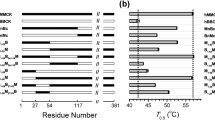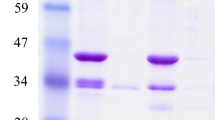Abstract
We investigated the effects of trehalose on thermal inactivation and aggregation of human brain-type creatine kinase (hBBCK) in this study. In the presence of 1.0 M trehalose, the midpoint temperature of thermal inactivation (T m) of hBBCK increased by 4.6 °C, and the activation energy (E a) for thermal inactivation increased from 29.7 to 41.1 kJ mol−1. Intrinsic fluorescence spectra also showed an increase in the apparent transition temperature (T 1/2) of hBBCK from 43.0 °C to 46.5 °C, 47.7 °C, and 49.9 °C in 0, 0.6, 0.8, and 1.2 M trehalose, respectively. In addition, trehalose significantly blocked the aggregation of hBBCK during thermal denaturation. Our results indicate that trehalose has potential applications as a thermal stabilizer and may aid in the folding of other enzymes in addition to hBBCK.





Similar content being viewed by others
Abbreviations
- CK:
-
Creatine kinase
- hBBCK:
-
Recombinant human brain-type CK
- T m :
-
Midpoint temperature of thermal inactivation
- E a :
-
Activation energy
- T 1/2 :
-
Apparent transition temperature of thermal denaturation
- λ max :
-
Maximum emission wavelength
References
Yancey, P. H. (2005). The Journal of Experimental Biology, 208, 2819–2830.
Auton, M., & Bolen, D. W. (2005). Proceedings of the National Academy of Sciences of the United States of America, 102, 15065–15068.
Leslie, S. B., Israeli, E., Lighthart, B., Crowe, J. H., & Crowe, L. M. (1995). Applied and Environmental Microbiology, 61, 3592–3597.
Rajendrakumar, C. S. V., Suryanarayana, T., & Reddy, A. R. (1997). FEBS Letters, 410, 201–205.
Wehner, F., Olsen, H., Tinel, H., Kinne-Saffran, E., & Kinne, R. K. (2003). Reviews of Physiology Biochemistry and Pharmacology, 148, 1–80.
Elbein, A. D., Pan, Y. T., Pastuszak, I., & Carroll, D. (2003). Glycobiology, 13, 17R–27R.
Kaushik, J. K., & Bhat, R. (2003). The Journal of Biological Chemistry, 278, 26458–26465.
Xie, G., & Timasheff, S. N. (1997). Biophysical Chemistry, 64, 25–43.
Carninci, P., Nishiyama, Y., Westover, A., Itoh, M., Nagaoka, S., Sasaki, N., et al. (1998). Proceedings of the National Academy of Sciences of the United States of America, 95, 520–524.
Hengherr, S., Heyer, A. G., & Köhler, H. R. (2008). The FEBS Journal, 275, 281–288.
Sun, W. Q., & Leopold, A. C. (1997). Comparative Biochemistry and Physiology A, 117, 327–333.
Auton, M., Bolen, D. W., & Rösgen, J. (2008). Proteins, 73, 802–813.
Bolen, D. W., & Baskakov, I. V. (2001). Journal of Molecular Biology, 310, 955–963.
Crowe, J. H. (2007). Advances in Experimental Medicine and Biology, 594, 143–158.
Sola-Penna, M., & Meyer-Fernandes, J. R. (1998). Archives of Biochemistry and Biophysics, 360, 10–14.
Bessman, S. P., & Carpenter, C. L. (1985). Annual Review of Biochemistry, 54, 831–842.
Lyubarev, A. E., Kurganov, B. I., Orlov, V. N., & Zhou, H. M. (1999). Biophysical Chemistry, 79, 199–204.
He, H. W., Zhang, J., Zhou, H. M., & Yan, Y. B. (2005). Biophysical Journal, 89, 2650–2658.
Gao, Y. S., Su, J. T., & Yan, Y. B. (2010). International Journal of Molecular Sciences, 11, 2584–2596.
Chen, L. H., White, C. B., Babbitt, P. C., McLeish, M. J., & Kenyon, G. L. (2000). Journal of Protein Chemistry, 199, 59–66.
Yao, Q. Z., Zhou, H. M., Hou, L. X., & Zou, C. L. (1982). Scientia Sinica, 25B, 1296–1302.
Turoverov, K. K., Haitlina, S. Y., & Pinaev, G. P. (1976). FEBS Letters, 62, 4–6.
Feng, S., & Yan, Y. B. (2008). Proteins, 71, 844–854.
Hottiger, T., Virgilio, C. D., Hall, M. N., Boller, T., & Wiemken, A. (1994). European Journal of Biochemistry, 219, 187–193.
Bong, S. M., Moon, J. H., Nam, K. H., Lee, K. S., Chi, Y. M., & Hwang, K. Y. (2008). FEBS Letters, 582, 3959–3965.
Aksenov, M., Aksenova, M., Butterfield, D. A., & Markesbery, W. R. (2000). Journal of Neurochemistry, 74, 2520–2527.
Katz, I. A., Irwig, L., Vinen, J. D., March, L., Wyndham, L. E., Lu, T., et al. (1998). Annals of Clinical Biochemistry, 35, 393–399.
Liu, R., Barkhordarian, H., Emadi, S., Park, C. B., & Sierks, M. R. (2005). Neurobiology of Disease, 20, 74–81.
Tanaka, M., Machida, Y., Niu, S., Ikeda, T., Jana, N. R., Doi, H., et al. (2004). Natural Medicines, 10, 148–154.
Acknowledgments
This work was supported by grants of Key Science and Technology Innovation Teams of Zhejiang Province (grant nos. 2009R50031 and 2009R50031-1) from the Science and Technology Department of Zhejiang Province and the Zhejiang Provincial Top Key Discipline of Modern Microbiology and Application (grant nos. KF2010006 and KF2010007). Dr. Zi-Ping Zhang was supported by grant 30970635 of the China National Science Foundation, grant Y2101329 of the Zhejiang Provincial Science Foundation, and the grant of the Scientific and Technological Research Programs of Ning Xia Hui Autonomous Region.
Author information
Authors and Affiliations
Corresponding authors
Additional information
Jiang-Liu Yang and Hang Mu contributed equally to this study.
Rights and permissions
About this article
Cite this article
Yang, JL., Mu, H., Lü, ZR. et al. Trehalose Has a Protective Effect on Human Brain-Type Creatine Kinase During Thermal Denaturation. Appl Biochem Biotechnol 165, 476–484 (2011). https://doi.org/10.1007/s12010-011-9266-3
Received:
Accepted:
Published:
Issue Date:
DOI: https://doi.org/10.1007/s12010-011-9266-3




